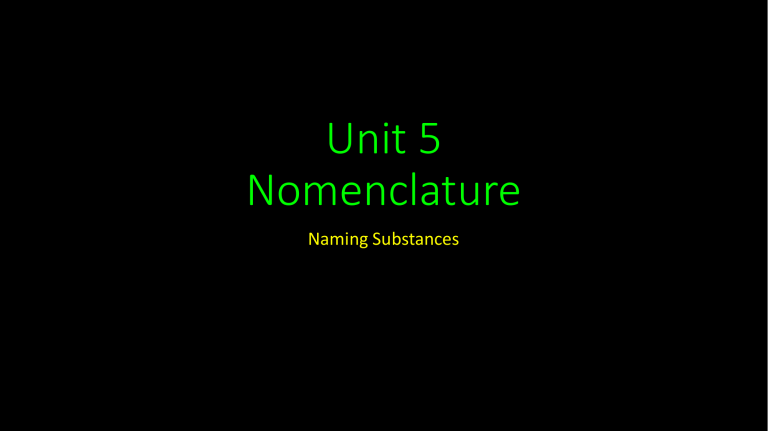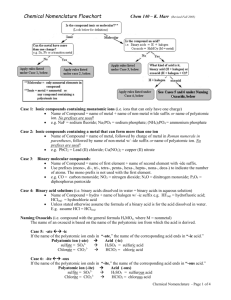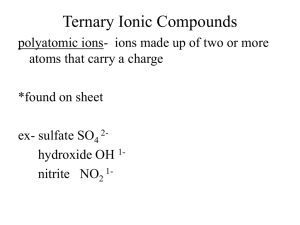Naming compounds PPT

Unit 5
Nomenclature
Naming Substances
Chemical Nomenclature
• Chemical nomenclature : the organized system used to name substances and write their chemical formulas.
• Chemical formula: uses element symbols and subscript numbers to represent the number of each kind of atom bonded together in a substance
• Subscript : indicates the number of atoms or ions present in the formula
Example of a Chemical Formula
Formula for water
Naming Ionic Compounds
Part 1
Review: What is an Ion?
• A charged atom due to the gain or loss of electrons
• Cation: Positively charged ion due to the loss of electrons
• Anion: Negatively charged ion due to the gain of electrons
Ionic Compounds
• Ionic compounds are formed when oppositely charged ions are attracted to each other.
• Strong electrostatic attractions.
• High melting point and boiling point solids.
• Capable of dissolving in water.
• Formed between a metal and a nonmetal
Monatomic Ionic Nomenclature
For cations:
• First word
• Keeps its elemental name
• Examples:
Na + is sodium ion
Al 3+ is aluminum ion
For anions:
• Second word
• Change the ending of the elemental name to -ide
• Examples:
Cl is chlorine
Cl – is chloride ion
S is sulfur
S 2– is sulfide ion
Binary Ionic Nomenclature
Metal (Group 1 or 2) + Nonmetal
Name Cation first, then anion
Examples:
• CaCl
2
: Calcium chloride
• MgO: Magnesium oxide
Practice: Name the Compounds
NaCl
A) Sodium Chlorine
B) Chloride Sodium
C) Sodiuide Chlorine
D) Sodium Chloride
MgI
2
A) Magnesium Iodine
B) Magneside Iodide
C) Magnesium Iodide
D) Iodide Magnesium
Practice: Name the Compounds
• BaI
2
• CaBr
2
Barium Iodide Calcium Bromide
Now Reverse it:
Given the name, write the chemical formula
• EX: Aluminum Chloride AlCl
3
• Steps:
1) Identify the element symbols
Al Cl
2) Write the charge on top for what the ions will be
Al 3+ Cl -
3) Use criss-cross method to identify the subscript numbers
Al 3+ Cl AlCl
3
Practice: Write the Chemical Formulas
• Calcium Iodide
Ca I
Ca 2+ I (Criss-cross)
CaI
2
• Sodium Nitride
Na N
Na + N 3(Criss-cross)
Na
3
N
Polyatomic Ions
• Polyatomic ions are ions made up of more than one atom that act as an individual ion in a compound
• The charge applies to the entire group of atoms
• Examples:
• Ammonium NH
4
1+
• Sulfate SO
4
2-
Polyatomic Ions
• DO NOT change the subscripts of atoms within the ion
• Phosphate ion: PO
4
3-
• 4 means there are 4 Oxygen atoms in the ion
• 3- means the entire ion has a charge of negative 3
Polyatomic Ions
• If more than one polyatomic ion is needed, put parentheses around the ion, then add the subscript after the parentheses
• Ex: (PO
4
3)
2 indicates there are two phosphate ions
Naming Polyatomic Ions when Given a Chemical Formula
• If polyatomic is the cation , then list the name & add the anion name to the end
• Ex: (NH
4
)Cl: Ammonium chloride
• If polyatomic is the anion , then name the cation and list the polyatomic name
• Ex: Mg (NO
3
)
2
Magnesium nitrate
Practice
Name this compound: NaNO
3
A. Sodium nitrate
B. Sodium nitrite
C. Sodium nitrogen oxide
• Name this compound: Na
2
SO
4
Sodium Sulfate
Given the Name of a Polyatomic Ion, find the
Chemical Formula
• Follow the same criss-cross rules
• EX: Ammonium Oxide
1. Identify the symbols
(NH
4
) and O
2. Identify the charges on the ions
NH
4
+ O 2-
3. Criss-Cross charges to become the subscripts
(NH
4
)
2
O
Remember: If you need multiples of the polyatomic ion, put the formula in parentheses and add a subscript after the parentheses
Practice: Name to Chemical Formula
• What is the formula for Calcium Phosphate?
A. Ca
B. Ca
3
2
(PO
(PO
4
4
)
)
3
2
1. Calcium is Ca and Phosphate is PO
4
2. Ca ion will have a 2+ charge and
Phosphate ion will have a 3- charge
3. Criss-cross: the 3 becomes the subscript for Ca, the 2 becomes the subscript for the Phosphate group
Stock System- Ionic Compounds
• Transition Metal and Nonmetal
• Many Transition Metals have more than one charge
• Roman Numerals are used to indicate the charge
• Manganese (VII) Oxide (manganese has a +7 charge)
• Lead (IV) Oxide (lead has a +4 charge)
Stock System- Ionic Compounds
•
Use the Stock system only whenever more than one ion charge is possible for an element.
• Exceptions
Roman numerals are:
Needed Not needed
Ag +
Cd 2+
Zn 2+
Transition metals
Sn, Pb
Stock System Nomenclature
• Name to chemical formula
• Criss cross the charges
• Iron (II) nitride
Fe 2+ N 3-
Fe
3
N
2
Write the chemical formulas for the following compounds:
***Remember to cross the charges!
1. Tin (II) fluoride • SnF
2
2. Mercury (II) iodide HgI
2
3. Lead (IV) sulfate Pb(SO
4
)
2
4. Cadmium oxide • CdO
Stock System Nomenclature
• Chemical formula to name
• Split the compound
• Find the charge of the anion side
• Cation side + anion side = 0
• CuO
Cu O 2-
Cu must have a +2 charge for the charges to add to 0
Copper (II) oxide
Name the following compounds:
**Remember the overall charge of a compound is 0!!!
1. HgS
2. CoF
3
3. PbCl
2
4. ZnBr
2
5. Fe
2
O
3
• Mercury (II) oxide
• Cobalt (III) fluoride
• Lead (II) chloride
• Zinc bromide
• Iron (III) oxide

